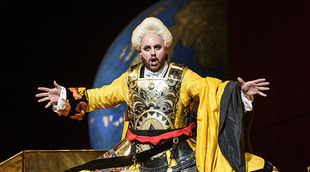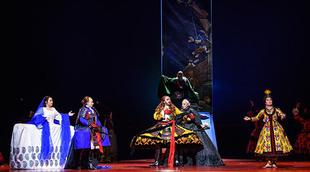 © (c) ROH - Catherine Ashmore
© (c) ROH - Catherine Ashmore
Based on a play by Jean Racine, Mitridate, re di Ponto is an early Mozart opera that premiered in December 1770. The musicologist Daniel E. Freeman recently demonstrated that Mozart incorporated some musical motives from Josef Mysliveček’s La Nitteti, which was first performed in April 1770 just a month after the young Amadeus first met the older composer, into his own operatic setting. Nevertheless, this hardly detracts from the achievement of a fourteen-year old composing such an accomplished full-length piece.
Although the mature Mozart introduced many innovations into opera, this early work is very much grounded in well-established traditions such as the utilisation of lengthy recitative. While, however, it features only two ensemble numbers it does possess a wide range of virtuoso arias, making it worth experiencing for far more than the reason of simply ticking another Mozart rarity off the list.
Set in 63BC during the conflict between Rome and Pontus, the story concerns Mitridate who is king of the latter. At the start he has just been defeated in battle and is presumed dead. His fiancée Aspasia is actually loved by both of his sons, Farnace and Sifare, but they are very different characters. Farnace is all too ready to conspire with the Romans in order to further his own ambitions. Sifare, on the other hand, is always loyal to his father, and it is his love that Aspasia reciprocates. It then transpires that Mitridate is alive and about to return home. Both sons initially agree to unite and tell Mitridate nothing of their love for Aspasia, but the truth soon comes out with Mitridate learning of Farnace’s treachery and Aspasia and Sifare’s apparent disloyalty. At one time or another, all three of them are threatened with death, but the situation is resolved after Mitridate, following further defeat, commits suicide. Before he does so he gives his blessing to Sifare to marry Aspasia, while Farnace sees the error of his ways and is accepted back into the fold as he agrees to marry the Parthian Princess Ismene. All four of them then pledge to free the world from Rome.

Michael Spyres (Mitridate) (c) ROH / Bill Cooper

Mitridate (c) ROH / Bill Cooper
In many of his later works, including his three collaborations with the librettist Lorenzo Da Ponte, Mozart moved away from exploring traditional operatic subject matters based on mythology or stories from the ancient world to focus on human beings who felt more relevant to his time and indeed our own. As a result, it is relatively easy to set those pieces in a variety of eras including the modern world because the characters can still speak to us today. His early works, however, are grounded in a less naturalistic tradition and this presents its own challenges. There seems little point in reproducing the opera exactly as Mozart would have seen it staged, when opera houses are now different in nature and tastes have changed, but an updating would not necessarily work for such a stylised piece. Graham Vick’s classic 1991 production for the Royal Opera has an ingenious solution that strongly alludes to the manner of eighteenth century performance without reproducing it to the letter. In this way, the bold red walls of Paul Brown’s set serve the dual purpose of enabling the drama to rise to the scale demanded of the large Royal Opera House, and making some moments feel suitably intimate by being positioned so as to restrict the size of the stage.
The beautiful costumes, in which tunics and dresses possess skirts that stick out to an alarming degree, allude to the lavishness of eighteenth century dress. By exaggerating their size, however, it sees the performers become an integral part of a dramatic set-up. The same could be said of the gestures, which work from the fact that eighteenth century performance did use stock actions to signify different feelings and emotions. Here these are put together so that soloists’ bodies sometimes display a continuous stream of fluid movement as they do in Chinese opera.
Mitridate’s attendants and soldiers march towards us with masks and tilted heads, visually illustrate the King’s sense of rage at Farnace’s treachery, and threateningly encircle him as Ismene pleads with Mitridate for clemency. For all that they dance on occasions, however, this production proves equally adept at knowing when not to introduce distractions to arias so that soloists can engage us purely through their own sounds, expressions and gestures.
Christophe Rousset on his Royal Opera debut conducts extremely well, while the cast is outstanding. Michael Spyres puts his smooth and strong tenor to good use in the title role while Albina Shagimuratova displays a beautifully full soprano that is possessed of many nuances and, when necessary, the utmost sensitivity. Bejun Mehta reveals an excellent countertenor as he thoroughly embodies both Farnace’s malevolence and subsequent repentance, while Lucy Crowe is a brilliant Ismene, revealing a beautifully clean and pure soprano and perfectly capturing her character’s nature through the strength of her movements. Salome Jicia reveals a fine and supple mezzo-soprano as Sifare while Jennifer Davis and Rupert Charlesworth provide excellent support as Arbate and Marzio respectively.
By Sam Smith
Mitridate, re di Ponto| 26 June – 7 July 2017 | Royal Opera House, Covent Garden
the 01 of July, 2017 | Print
Comments